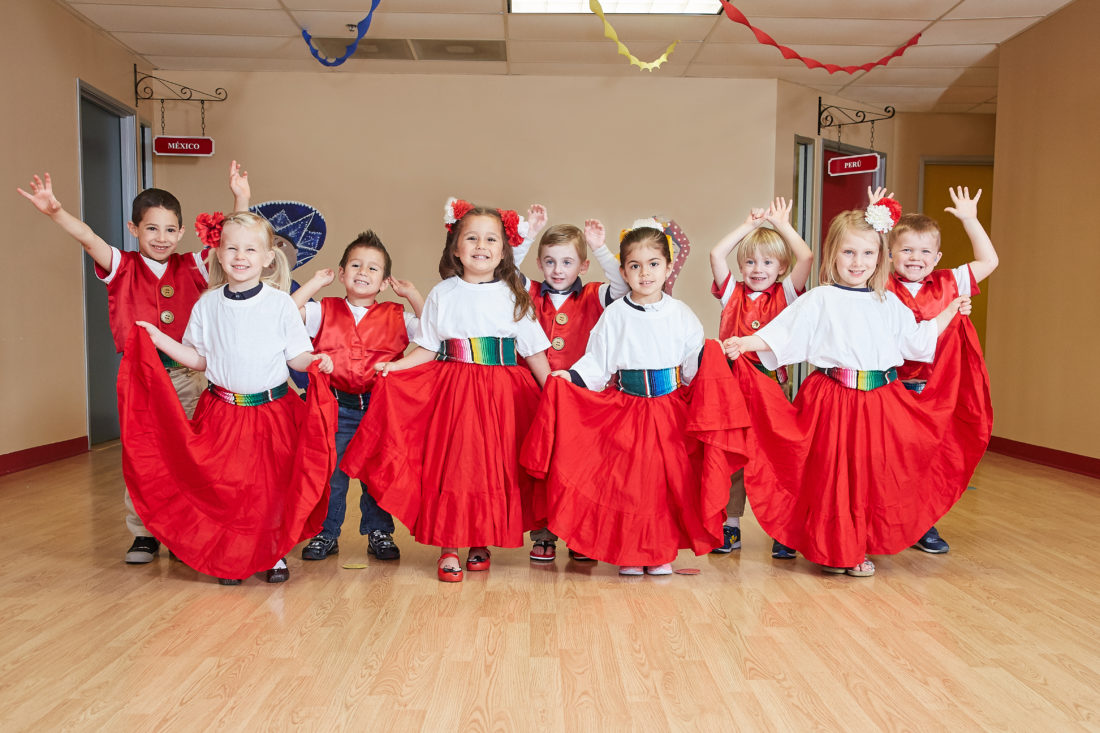
Immersion simply means being surrounded by a language so it can be acquired naturally. Children have an innate ability to learn language by hearing it spoken to them or around them. In our Spanish immersion environment, children are surrounded by the Spanish language and they learn it through the natural interactions of school activities and social experiences. In this environment, communication happens spontaneously and conversation is key!
Cognitive Benefits
Over three decades of research has shown that children who study a foreign language tend to have greater cognitive development than their monolingual peers. This is demonstrated in such skills as enhanced creativity, memory, focus, problem-solving, flexible thinking, and ability to multi-task. Scientists propose that the processes used in learning languages require more attention and harder thinking, which in turn has a positive effect on overall cognitive development. (Bamford and Mizokawa, 1991; Kovacs and Mehler, 2009; Bialystok et al., 2013)
Physiological Benefits
Evidence suggests that being bilingual from an early age physically changes the brain's structure and increases brain activity. Brain matter in bilingual people has been shown to be denser than that of monolingual people in both hemispheres, particularly in the left hemisphere (which controls language and communication skills). (Kovelman et al., 2008; Mechelli, 2004)
Other studies show that learning foreign languages reduces age-related cognitive loss and delays the onset of dementia (Bialystok, Craik, Freedman, 2010)
Academic Benefits
Studies consistently show that people who are competent in more than one language outscore monolinguals on tests of verbal and nonverbal intelligence (Cloud et al., 2000; Hakuta and Weatherford, 1986; Bruck et al., 1974) The College Entrance Examination Board (1992, 1982) reported that students who had averaged four or more years of foreign language study scored higher on the verbal section of the Scholastic Aptitude Test (SAT) than those who had studied four or more years of any other subject.
Social and Career Opportunities
Being bilingual opens doors to communication with more people, in more places! As world communities are becoming increasingly interdependent, languages allow us to interact competently. Knowing a second language can also give people a competitive advantage in the work force by opening up additional job opportunities (Villano, 1996). It's clear that speaking multiple languages is a valuable asset!
More Potential!
Studies show that the neurons of a newborn's mind are "unprogrammed" and full of potential, providing an ideal opportunity for second language learning (Begley, 1996). Brain scan technology supports the theory of critical periods of development when a child's brain is highly susceptible to environmental experiences. (Kulh, 2010; Brown, 1994; Fromkin and Rodman)
The window for language learning is generally thought to be through age ten. During these years, the circuits in children's brains become wired for how language sounds. Repeated exposure to words helps the brain build the neural connections for further language development. The more years devoted to learning a language and the more opportunities available to use it in everyday situations, the greater the proficiency achieved (Curtain, 1997).
Language Mastery is Easier
Intense neural activity in early childhood opens the brain to new sounds and patterns, allowing better mimicking of sounds and pronunciation. Children who learn a language before adolescence are more likely than older learners to attain native-like pronunciation (Harley, 1986; Patkowski, 1990).
Lower Inhibitions
Emotionally, children are often less inhibited about making mistakes than adolescents or adults are. This lowers what language acquisition experts call the "affective filter" (Krashen, 1985), making them more likely to try out and use a foreign language.
Center for Applied Linguistics - very specific studies on all aspects of language acquisition
American Council on the Teaching of Foreign Languages - compilation of research
National Council of State Supervisors for Languages - research findings on benefits of bilingualism
Bilingual Families Web Page - lots of great resources for parents who want their children to be bilingual